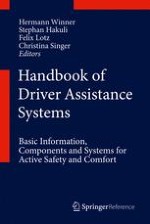This fundamental work explains in detail systems for active safety and driver assistance, considering both their structure and their function. These include the well-known standard systems such as Anti-lock braking system (ABS), Electronic Stability Control (ESC) or Adaptive Cruise Control (ACC). But it includes also new systems for protecting collisions protection, for changing the lane, or for convenient parking.
The book aims at giving a complete picture focusing on the entire system. First, it describes the components which are necessary for assistance systems, such as sensors, actuators, mechatronic subsystems, and control elements. Then, it explains key features for the user-friendly design of human-machine interfaces between driver and assistance system. Finally, important characteristic features of driver assistance systems for particular vehicles are presented: Systems for commercial vehicles and motorcycles.
